Thermal Defense by Japanese Honeybees
In Japan, a unique and mysterious fight has been carried on between Japanese honeybee and giant hornet from prehistoric days. This fight has been captured as a clear thermal image data by TVS. A research paper authored by Dr.Masato Ono, Lecturer at Faculty of Agriculture, Tamagawa University, appeared on the British scientific magazine, NATURE.
Giant hornet is the world strongest predatory bee. Because they are big, they cannot prey upon speedy small creatures. During spring to summer time, they eat slow moving insects such as the gold beetle or large caterpillar. From late August to October, however, when the nest of the giant hornet grow to its maximum size, these insects become scarce. So they attack Japanese honeybee hives.
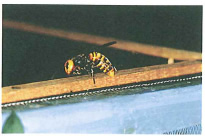
Photo 1
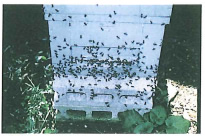
Photo 2
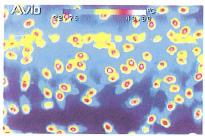
Photo 3(TVS-8100 was used)
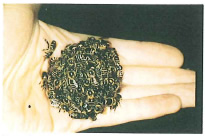
Photo 4
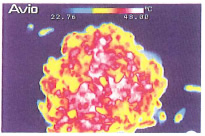
Photo 5
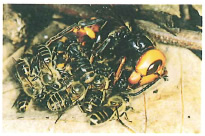
Photo 6(TVS-8100 was used)
First, when the scout giant hornet finds a Japanese honeybee hive, it scents in the periphery of the prey food by secretion of pheromones from the terminal of its hypogastrium. (Photo 1) Then the attacking force of the giant hornet arrives aiming at the scent and attacks the Japanese honeybee hive. On the other hand, Japanese honeybees perceive the attack based on the pheromones of the giant hornet and prepare for defense. Many guards come out of the beehive (Photo 2), raise their own body temperature to 48℃ by vibrating their flight muscle and wait for the attack (Photo 3). When the giant hornet comes, Japanese honeybees cluster around each giant hornet (Photos 4 and 5) and kill it by steaming. After 10 to 20 minutes, the giant hornet dies and Japanese honeybees gradually leave the area (Photo 6).
Giant hornet dies when the outside temperature exceeds 45℃. On the other hand, Japanese honeybees can survive up to 50℃. Japanese honeybee, an insect of cold-blooded animal, takes advantage of the difference of maximum fatal temperature between the two species and takes their defensive activity by changing their own body temperature. This defensive measure, however, is not perfect. If nests of the two species are too close to each other, unfortunately, there will be too many giant hornets to be clustered around. As a result, Japanese honeybee hive will be looted completely.
As such, based on the mysterious system created by the nature, Japanese honeybees and giant hornets maintain a delicate balance and live together without ruining one side.
- *Material presented by courtesy of Dr.Masato Ono. Lecturer at Faculty of Agriculture, Tamagawa University.
